Customer journey mapping is key to improving experiences across touchpoints – from websites to in-store visits. AI tools simplify this process by analyzing data, predicting customer behavior, and automating engagement. Here’s a quick look at 10 AI-powered platforms that help businesses improve customer satisfaction, reduce costs, and boost ROI:
- SuperAGI Journey Orchestration: AI agents unify customer profiles, automate workflows, and improve engagement with predictive analytics.
- Qualtrics XM: Combines predictive insights and data integration to identify pain points and optimize journeys.
- Adobe Experience Platform: Uses machine learning for real-time personalization and journey mapping.
- Pointillist: Maps customer experiences with predictive modeling and real-time analytics.
- InMoment: Focuses on feedback analysis and multi-channel data integration.
- Thunderhead ONE: Predicts customer intent and automates engagement based on real-time data.
- Kitewheel: Offers platform-agnostic journey orchestration and AI-driven analytics.
- JourneyVision Pro: Affordable option ($25/month) with dynamic journey mapping and predictive tools.
- Usermind: Integrates data from CRMs and marketing tools for tailored customer interactions.
- Genesys DX: Connects digital and physical touchpoints with predictive engagement and automation.
Quick Comparison
| Tool | Key Feature | Starting Price |
|---|---|---|
| SuperAGI | Predictive analytics, AI agents | Custom pricing |
| Qualtrics XM | Predictive insights, feedback analysis | Custom pricing |
| Adobe Experience | Machine learning, real-time data | Custom pricing |
| Pointillist | Predictive modeling, real-time maps | Custom pricing |
| InMoment | Sentiment analysis, feedback tools | Custom pricing |
| Thunderhead ONE | Intent prediction, omnichannel data | Custom pricing |
| Kitewheel | Platform-agnostic, AI optimization | Custom pricing |
| JourneyVision Pro | Affordable, dynamic mapping | $25/month |
| Usermind | CRM integration, tailored workflows | Custom pricing |
| Genesys DX | Predictive engagement, automation | Custom pricing |
For small budgets, JourneyVision Pro is a solid choice. Larger businesses may prefer Adobe Experience Platform or Genesys DX for advanced features. Choose based on your goals, data needs, and budget.
A Deeper Dive Into AI-Powered Journey Mapping
1. SuperAGI Journey Orchestration
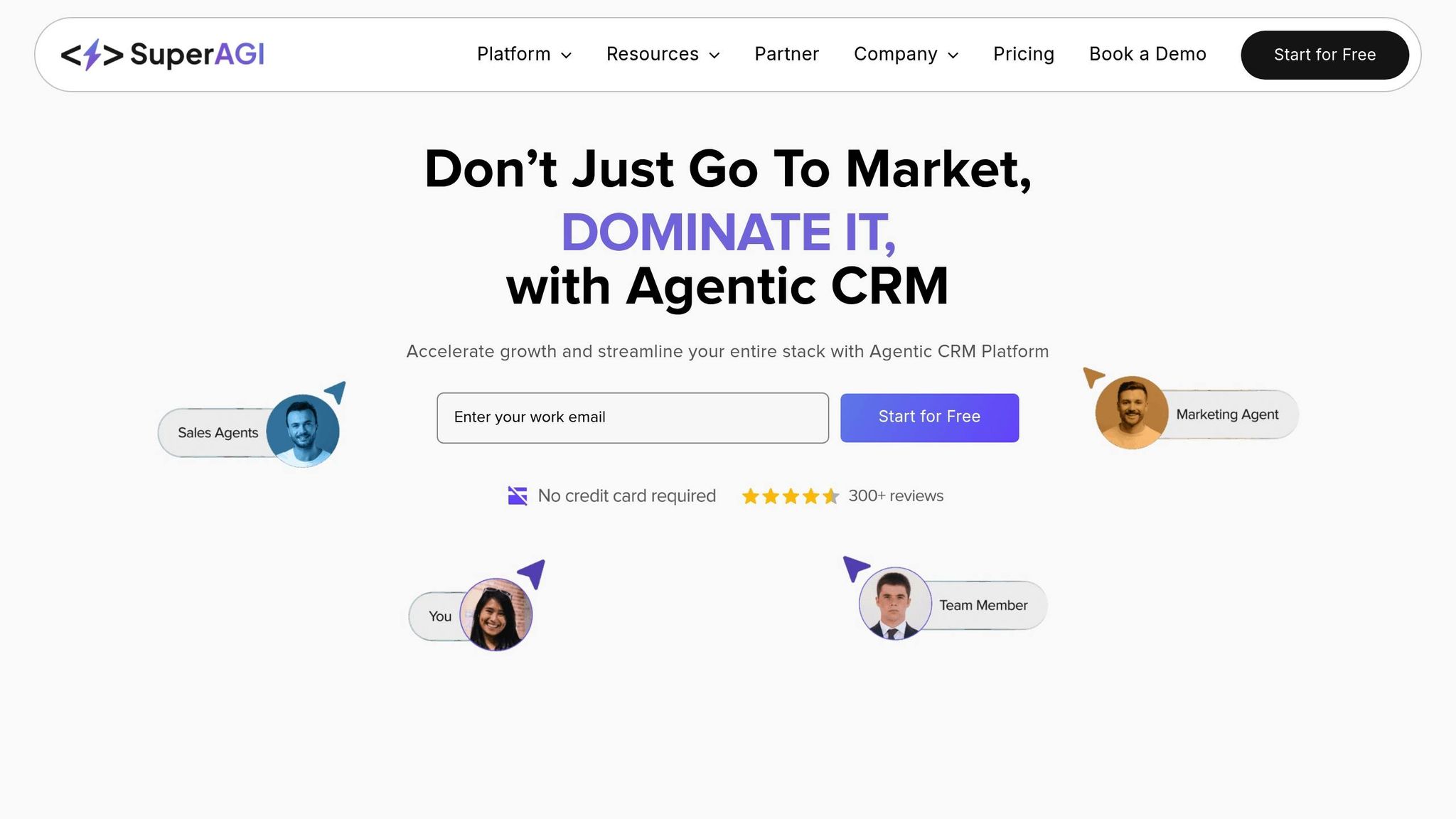
SuperAGI Journey Orchestration is a robust platform that uses AI agents to deliver a complete customer profile across all interaction points. It bridges the gap between offline and online experiences, creating a unified and smooth customer journey. By breaking down silos between sales, marketing, and customer service, it provides a single, cohesive view of each customer’s interactions.
AI Capabilities
SuperAGI leverages predictive analytics and machine learning to anticipate customer needs and predict conversion potential with precision. Its AI-powered segmentation automatically groups customers based on their behavior, preferences, and demographics, continuously improving through reinforcement learning with each interaction.
"Our platform features AI agents that analyze customer behavior, preferences, and interactions to forecast future needs." – SuperAGI
American Express offers a compelling example of how AI-driven journey orchestration can make a difference. By automating their customer service processes with similar technology, they achieved a 20% cost reduction and a 15% boost in customer satisfaction. These benefits underscore the practical impact of integrating AI into customer journeys.
Data Integration
The Agentic CRM Platform by SuperAGI excels at unifying offline and online customer interactions into a single, seamless view. Whether a customer shops in-store, browses online, or contacts customer service, the platform connects these touchpoints to create a comprehensive journey map.
Its omnichannel messaging feature ensures businesses can communicate with customers across various platforms without overwhelming them. This approach balances reach with relevance.
Organizations using SuperAGI’s platform have reported impressive results, including up to 30% greater sales efficiency, 25% reductions in operational complexity and costs, and 20% gains in customer engagement and retention. These outcomes highlight how integrated data fuels better decision-making and visualization.
Visualization and Reporting Tools
SuperAGI includes a visual workflow builder designed to make creating and automating multi-step, cross-channel customer journeys straightforward. Instead of requiring technical expertise, users can design workflows with a simple drag-and-drop interface, making it easier to understand and improve customer interactions.
The platform also features real-time audience segmentation tools, enabling businesses to create dynamic customer groups based on factors like demographics, behavior, or custom traits. These segments can be targeted with personalized messaging that evolves alongside customer behavior.
Automation for Journey Orchestration
Automation is a core strength of SuperAGI. Beyond automating email sequences, the platform’s AI agents can draft content, refine journeys, and adjust messaging in real time based on customer responses and behaviors.
The system continuously monitors interactions and adapts journey paths dynamically. This level of automation significantly enhances productivity, with embedded AI agents driving 10x efficiency by delivering behavior-triggered messaging that boosts conversion rates.
2. Qualtrics XM

Qualtrics XM takes journey mapping to the next level by combining predictive analytics with integrated data. With its AI-driven insights and seamless data integration, it helps businesses map customer journeys and pinpoint both obvious and subtle pain points.
AI Capabilities
The platform’s AI engine analyzes experiences from customers, employees, and prospects to provide predictive insights. It forecasts behaviors, offers proactive recommendations, and identifies at-risk customers before dissatisfaction becomes evident.
For example, Canon used Qualtrics XM to revolutionize its customer service. By analyzing feedback, they pinpointed service gaps and achieved a 30% boost in customer satisfaction. Likewise, UPS utilized the platform to assess delivery feedback, cutting customer complaints by 25%.
Data Integration
A standout feature of Qualtrics XM is its ability to unify data from multiple channels. The XM Directory acts as a central hub, linking digital intercepts with traditional survey responses to create a complete view of the customer journey.
Offline survey data is seamlessly connected with online interactions, ensuring every touchpoint – whether in-store, online, or through support – is tracked and mapped. The platform also manages contact frequency across channels to avoid over-surveying, capturing feedback at the right moments. Additionally, it enriches customer profiles by embedding contact data into survey responses, making every interaction more meaningful. This robust data integration lays the groundwork for clear insights and automated journey improvements.
Visualization and Reporting Tools
Qualtrics XM simplifies complex data with a range of visualization tools. Customizable journey charts reveal drop-offs and friction points, helping businesses focus on areas needing improvement.
One standout tool, the Journey Chart Widget, maps customer movements across touchpoints, highlighting where they drop off or face challenges. Beyond standard visuals, the platform offers advanced options like gauge charts, breakdown bars, and text highlights for deeper analysis. Custom color schemes and titles ensure that reports align with brand aesthetics.
Automation for Journey Orchestration
Automation is where Qualtrics XM truly shines. Its Customer Journey Optimizer uses conversational analytics to evaluate journey value and uncover opportunities for improvement without requiring manual input.
The system logs touchpoint events automatically, building a detailed history that clearly identifies friction points. By integrating with CRM and marketing automation tools, the platform enables businesses to act on insights effectively. For instance, if the AI flags a customer as at risk, it can trigger personalized actions in connected systems to address the issue promptly.
3. Adobe Experience Platform
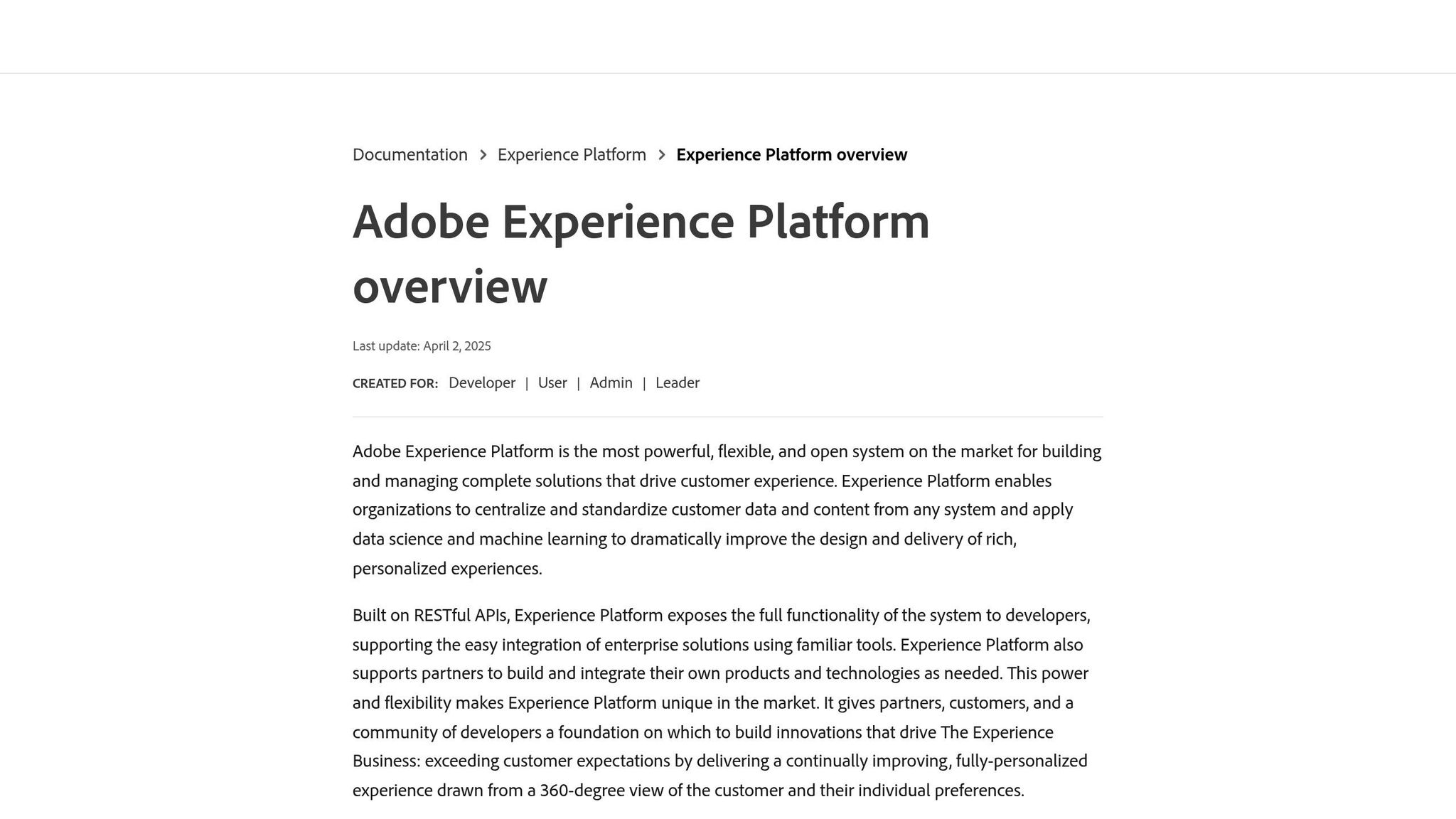
Adobe Experience Platform brings together customer data from all touchpoints, processing it in real time with the help of AI to deliver personalized experiences on a large scale. Let’s dive into its standout features, including AI capabilities, data integration, visualization tools, and automation, that make it a powerful tool for mapping customer journeys.
AI Capabilities
The platform’s AI engine provides predictive insights to guide decision-making. Customer AI uses machine learning to generate propensity scores, predicting behaviors like churn risk or the likelihood of conversion. This helps businesses identify at-risk customers and focus on high-value prospects.
The AI Assistant simplifies complex tasks for marketers, enabling them to uncover data patterns, create targeted audiences, and fine-tune campaigns – no technical expertise required. Other AI-driven tools include Algorithmic Attribution, which pinpoints the touchpoints driving conversions, Anomaly Detection for identifying unusual customer behavior, and Intelligent Captions, which automatically summarize insights from data visualizations.
For example, in retail, Customer AI can predict which products a customer is likely to buy. Financial services use it to find potential new account holders, while media companies rely on it to foresee which subscribers might cancel their services.
Data Integration
Adobe Experience Platform seamlessly integrates and normalizes data from both online and offline sources in real time, ensuring compatibility with existing systems.
Its Customer Journey Analytics connects customer identities and interactions across different channels, devices, and timeframes, creating a unified view of the customer journey – whether they’re browsing online, shopping in-store, or contacting customer service.
It also supports third-party integrations like Invoca, which merges data from digital and offline channels. For instance, Viasat used this feature to boost call conversions by 74% by addressing drop-offs in their sales flow. Similarly, eHealth reduced their click-to-call cost per acquisition by 60% by gaining a comprehensive view of their customers.
"Invoca’s Adobe integration has really improved how we track the customer journey… Having that visibility is key for us, and it’s helped us make the customer experience a lot more seamless." – Viasat
Visualization and Reporting Tools
The platform’s Analysis Workspace offers an intuitive drag-and-drop interface, making complex data easy to understand for marketers without technical expertise. It supports the creation of freeform tables, cohort analyses, fallout diagrams, flow charts, and journey visualizations to analyze customer behavior.
One standout tool, the Journey Canvas, provides detailed insights into user journeys, showing exactly where customers drop off or continue. Unlike traditional funnel analysis, it captures non-linear journeys with multiple entry points, reflecting how customers interact with brands today.
For teams that prefer external tools, the BI extension allows SQL access, integrating seamlessly with platforms like Power BI and Tableau. This ensures that everyone in the organization can work with the data in their preferred environment while maintaining consistency.
The platform handles billions of data points in milliseconds, enabling real-time reporting to keep up with fast-changing customer interactions. Karen Hopkins, Global CMO at EY, highlights the platform’s impact:
"I’ve always had a vision of looking at marketing data more holistically from an account perspective – not an easy task when dealing with global clients and organizations. Adobe solutions work together to help us connect teams and find more proactive ways to work with clients."
Automation for Journey Orchestration
Adobe Experience Platform turns insights into action with robust automation tools. It triggers personalized experiences automatically based on customer behavior and their stage in the journey.
With Adobe Journey Optimizer, businesses can manage complex, multi-channel campaigns that adapt in real time. Macy’s used this technology to overhaul their customer journey strategy, as Bennett Fox-Glassman, SVP of Customer Journey, shared:
"Just looking at our first use cases, we’ve already generated great engagement and results…We’ve transformed how our teams work together and the technology we use to put customer journeys front and center."
Automation also extends to audience creation and campaign optimization. AI-driven recommendations enable marketers to make quick, data-informed decisions, while natural language prompts in Analysis Workspace make analytics accessible to a wider range of teams.
4. Pointillist
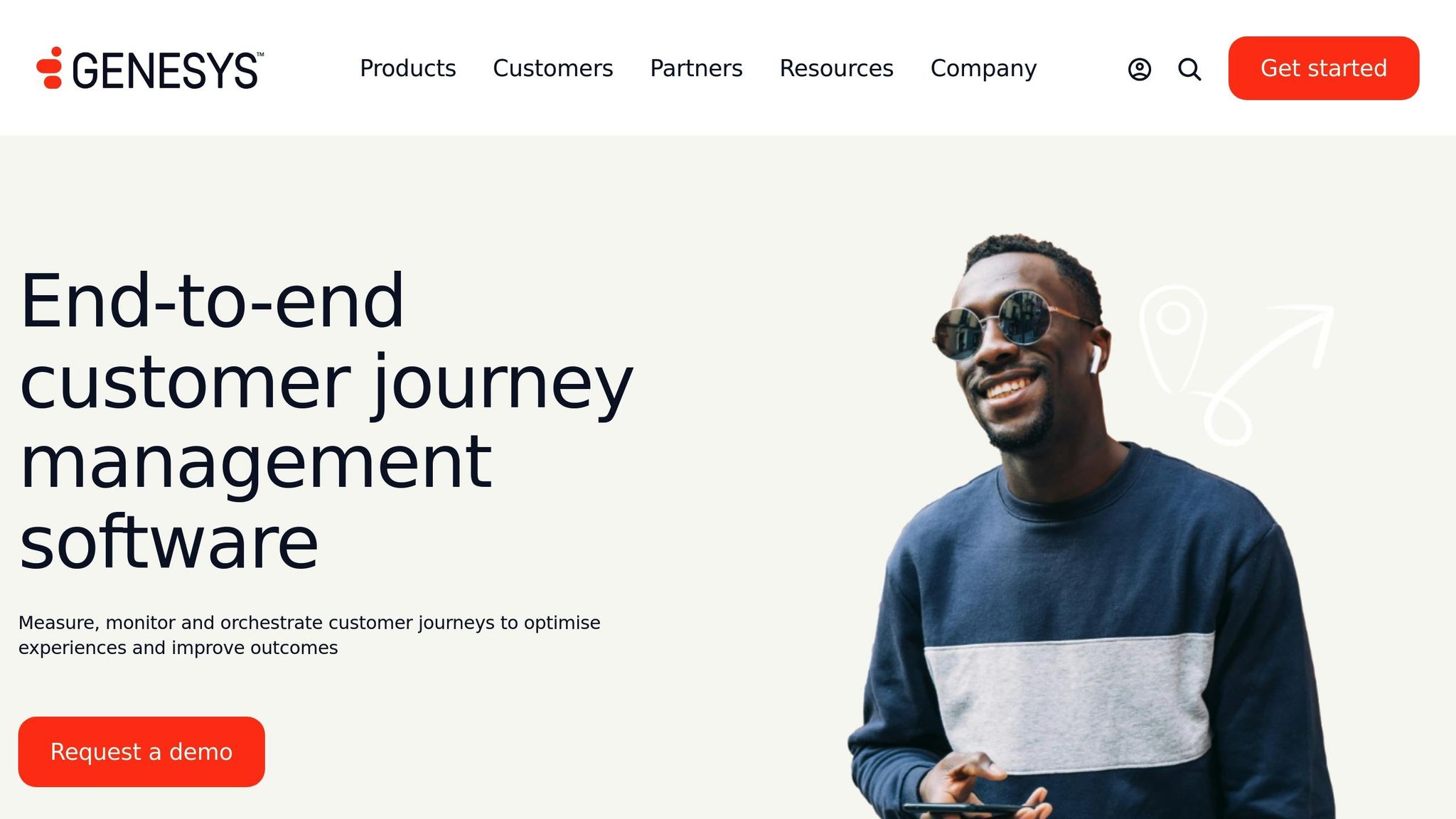
Pointillist stands out as a tool designed to transform how businesses analyze and optimize customer experiences. By blending advanced artificial intelligence with seamless data integration, it provides a unified view of customer interactions across all touchpoints.
AI Capabilities
With its AI-driven approach, Pointillist quickly identifies issues and highlights areas for improvement in customer journeys. Using predictive modeling, it extracts valuable insights from customer journey data, helping businesses make informed decisions.
Data Integration
The platform’s Customer Journey Data Hub brings together data from multiple sources, creating a single, unified customer view. Its Agile Data Fusion method starts with core data sources and gradually expands, incorporating data from CRMs, web analytics, email platforms, contact centers, and more. Real-time identity resolution links events across shared customer identifiers, ensuring seamless data integration as information flows into the hub.
Andrew George, Director of Direct and Integrated Marketing at Canadian Red Cross, shared how Pointillist has impacted their operations:
"The platform enables us to integrate data from our customer touchpoints across time and channel into one view. It reveals the actual paths that donors would take across channels over time – and not just how we wanted them to do it – and we’ve been able to link donor behavior to our actual key performance indicators."
Visualization and Reporting Tools
Pointillist offers dynamic journey mapping tools, making it easier for businesses to visualize and analyze customer experiences at every stage. Detailed reports highlight performance trends, turning complex data into actionable insights for both analysts and business teams. Advanced analytics provide deeper customer insights, while the Pointillist Community feature enables real-time collaboration, allowing teams to share findings and align on metrics.
One of the platform’s standout features is its real-time analytics, which allows businesses to monitor customer journeys as they happen and respond proactively. This capability addresses a major challenge for CX leaders, as 40% report that fragmented data and analytics hinder their ability to deliver a seamless customer journey. By bridging this gap, Pointillist empowers organizations to enhance their customer experience strategies effectively.
5. InMoment
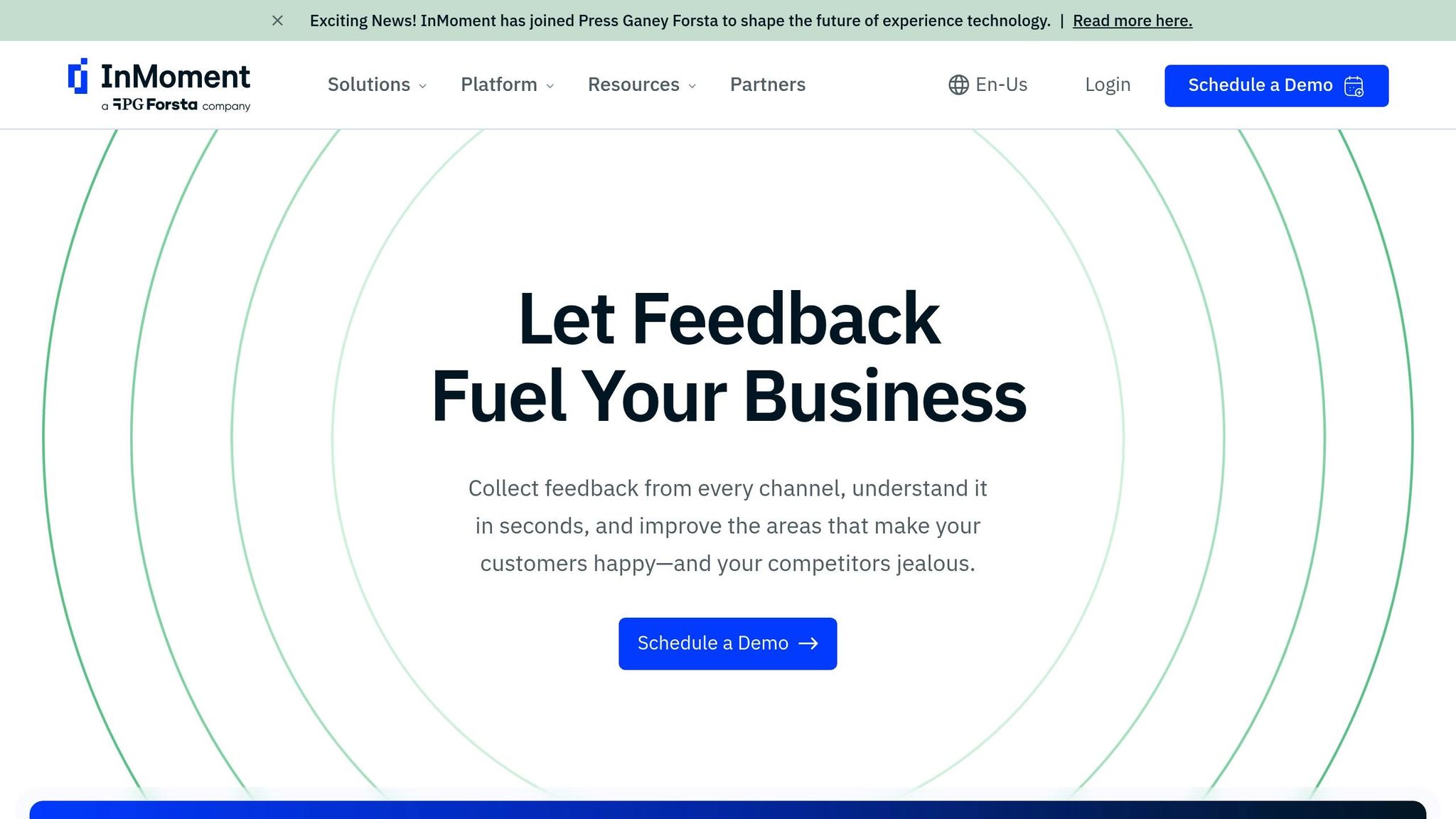
InMoment combines AI with advanced data integration to bring together customer interactions from various touchpoints. The platform aims to eliminate data silos, offering a comprehensive view of customer experiences across both online and offline channels. This unified approach provides businesses with deeper insights into the entire customer journey.
AI Capabilities
InMoment uses machine learning and natural language processing to enhance feedback analysis and predict customer behavior. Its AI Journey Insights feature automatically maps customer touchpoints from unstructured data, while Smart Summaries condense large volumes of feedback into actionable takeaways.
Jeff Catlin, SVP of Integrated CX and AI Products at InMoment, highlights the platform’s transformative capabilities:
"AI Journey Insights breaks down these barriers by automatically mapping customer touchpoints across all channels and journey stages, providing a comprehensive view of the customer experience from every vantage point."
By organizing insights based on journey stages, the platform has been shown to improve customer satisfaction by up to 30% and reduce decision-making time by 40%.
Data Integration
InMoment stands out for its ability to consolidate customer insights from multiple channels into a single, standardized framework. It integrates both structured and unstructured data from sources like surveys, reviews, contact center interactions, and other feedback channels.
This approach combines direct customer feedback with unified experience management data, helping brands uncover actionable insights. By moving beyond siloed, channel-specific metrics, businesses gain a complete view of the customer journey.
The platform also tracks interactions across offline and online channels, automatically analyzing unstructured data to map the full customer journey. This unified foundation feeds into its powerful visualization tools, ensuring businesses have a clear and actionable picture of customer experiences.
Visualization and Reporting Tools
InMoment provides customizable reports and dashboards designed to meet the needs of various stakeholders. These tools empower users to create, interpret, and share data-driven strategies effectively.
The platform’s reporting features include pre-built reports, self-service dashboard creation, omnichannel performance tracking, and mobile-friendly reporting. By integrating data from surveys, reviews, transcripts, and videos, it delivers insights through interactive charts and dynamic widgets.
Advanced filters and grouping options ensure that the right insights reach the right audience at the right time. According to InMoment, this integrated approach can increase customer lifetime value and improve bottom-line results within just 12 months, compared to the industry average of 25 months.
One real-world example highlights the platform’s impact: a customer journey map revealed that employees lacked proper training to meet service standards. This insight enabled the organization to address the issue, improving both customer and employee experiences.
6. Thunderhead ONE
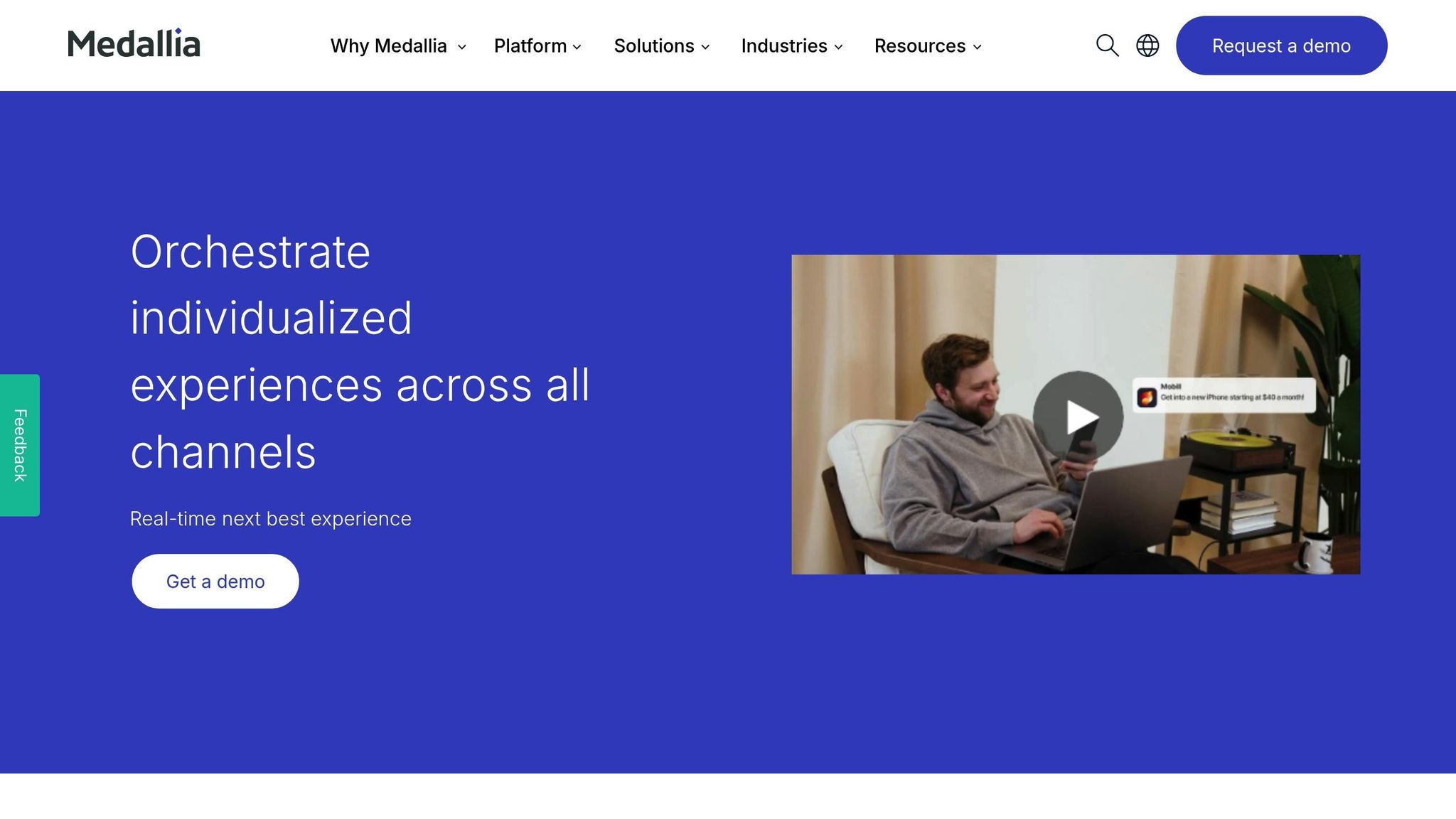
Thunderhead ONE stands out by actively analyzing customer intent in real time. Acquired by Medallia in early 2022, the platform blends machine learning with real-time decision-making tools to deliver tailored experiences across every customer interaction point. Instead of merely reacting to past behaviors, its AI-powered decision engine predicts future actions, creating meaningful connections with customers.
AI Capabilities
Thunderhead ONE’s AI features are designed to provide detailed, real-time insights that drive proactive engagement. By harnessing machine learning, the platform processes billions of interaction events and uses its Intent Analyzer to uncover behavioral patterns, revealing the true intent behind customer actions.
This predictive capability not only anticipates customer responses but also measures the value of each interaction. With these insights, marketers can make informed decisions about the timing and content of their messaging.
Glen Manchester, CEO and Founder of Thunderhead, underscores the platform’s forward-thinking approach:
"In today’s connected digital economy, it’s critical for brands to move beyond the rear-view mirror world of traditional digital marketing and be proactive in their ability to anticipate the real needs of their customers."
By focusing on intent-driven journey analytics, businesses gain a deeper understanding of customer preferences, enabling more precise and impactful experiences. Companies using platforms like Thunderhead ONE often report a 15% boost in customer retention rates and a 10% increase in revenue.
Data Integration
One of Thunderhead ONE’s strengths lies in its ability to unify data from various sources, creating a comprehensive view of each customer. The platform uses a JavaScript tag to track web and email interactions and offers an SDK for mobile app integration. For businesses with existing systems, it supports REST API connections and batch file imports.
It also provides prebuilt API connectors for major CRM systems like Salesforce.com, Microsoft Dynamics CRM, and SAP Cloud for Customer. This integration capability allows businesses to link disparate data points – such as connecting an email address to a web browser cookie or a mobile device through app registration. The platform can even track anonymous users, later merging their activity with personal profiles once they identify themselves. This ensures a smooth transition from anonymous browsing to personalized engagement, preserving valuable behavioral data.
This unified data approach enables Thunderhead ONE to map both offline and online customer journeys seamlessly.
Automation for Journey Orchestration
Thunderhead ONE’s automation tools are designed to streamline customer engagement. The platform creates "conversations" that deliver targeted messages based on a customer’s journey stage, attributes, and preferred communication channels. Using machine learning, it predicts customer responses and calculates the value of each interaction before deployment.
Through API connections, Thunderhead ONE can push personalized content to other systems, such as email platforms, allowing businesses to enhance their existing marketing tools with its orchestration capabilities. By automating engagement across all touchpoints, the platform ensures a cohesive experience that bridges offline and online interactions.
Eamon Collins, Group Marketing Director at PageGroup, reflects on the platform’s impact:
"Thunderhead’s ONE is a unique platform for customer engagement and quickly gives us the ability to truly understand our candidates and clients and service their needs in real-time, marking a momentous point in our ability to build engagement."
Visualization and Reporting Tools
To complement its predictive capabilities, Thunderhead ONE offers advanced visualization tools that turn data into actionable insights. Its Intent Analyzer uses a marketing-specific query language to examine omnichannel customer journey behavior, helping marketers uncover deeper insights.
The platform builds dynamic customer profiles, enabling sales and marketing teams to engage in more meaningful conversations. Monitoring tools identify customer intentions, while the platform’s visualizations present this data in a way that’s easy to interpret and act upon .
Additionally, Thunderhead ONE evaluates proposed journey designs against real customer behavior, ensuring planned experiences align with actual needs. This feature helps businesses fine-tune their customer journeys before rolling them out, saving time and resources while improving results.
sbb-itb-d6d4d8b
7. Kitewheel
Kitewheel provides a flexible, platform-agnostic solution for customer journey orchestration. This means businesses can integrate it with their existing marketing tools without needing to replace their entire system. It’s a great fit for organizations with established setups that want to improve their journey mapping capabilities without starting over from scratch.
Big names like Toyota and Universal Music Group have used Kitewheel to design smooth, data-driven customer journeys across multiple touchpoints. The results? Users have reported a 10% boost in sales, 10× more paid media engagements, and a 10-point jump in their Net Promoter Score (NPS).
Much like other tools mentioned earlier, Kitewheel focuses on connecting offline and online interactions, keeping the emphasis on integrated customer journey mapping.
AI Capabilities
At the heart of Kitewheel’s platform is its AI-powered customer journey hub, which offers three main features: real-time decisioning, journey analytics, and cross-channel orchestration. The decisioning engine reacts quickly to changing customer behaviors, while advanced analytics uncover patterns that help businesses make smarter choices. This AI-driven approach has been shown to improve customer satisfaction by 30–40% and boost retention rates by 20–30%.
Data Integration
One of Kitewheel’s standout strengths is how it seamlessly integrates offline and online data. Mark Smith, President of Kitewheel, highlights this capability:
"Overall, what made Kitewheel stand out against the other vendors in the reports is our ability to work across the entire customer journey spectrum by allowing users to design, orchestrate and measure journeys in a completely channel-agnostic way."
This ability to unify data creates a complete view of customer interactions, transforming basic campaign automation into more sophisticated journey orchestration. With this unified data, businesses can automate responses, making customer journeys smoother and more efficient.
Automation for Journey Orchestration
Kitewheel uses its strong data integration to automate critical journey touchpoints, ensuring real-time engagement. For instance, its real-time journey analytics can trigger personalized messages, like reminders for abandoned shopping carts, which help increase conversions. By analyzing customer interactions as they happen, businesses can make timely, informed decisions to keep experiences relevant and engaging.
Visualization and Reporting Tools
Kitewheel also offers tools to visualize and analyze customer journeys in real time. These features help businesses spot trends and uncover areas for improvement. With AI-powered journey mapping, companies have seen sales increase by 25% through personalized offers. This combination of real-time insights and clear visualizations makes it easier to refine customer experiences and drive better results.
8. JourneyVision Pro
JourneyVision Pro offers a budget-friendly yet highly capable AI solution for customer journey mapping, with plans starting at just $25 per month. This platform generates dynamic journey maps that evolve in real-time as customer behaviors shift, ensuring businesses stay in tune with their audience’s needs and preferences. It tracks interactions across multiple channels like social media, email, and phone, giving businesses a comprehensive view of the customer journey.
AI Capabilities
JourneyVision Pro leverages AI to automatically update journey maps as fresh customer data becomes available. Its predictive tools anticipate customer behavior, while the platform’s data analysis engine provides instant insights to guide smarter marketing decisions.
Data Integration
A standout feature of JourneyVision Pro is its ability to unify diverse data sources. It combines offline and online interactions – ranging from social media engagement to email and phone conversations – into a single, cohesive view. This ensures no customer action goes unnoticed. Given that 70% of customers now expect seamless experiences across all channels, this integrated approach addresses a critical demand.
Visualization and Reporting Tools
The platform’s user-friendly interface simplifies complex data, turning it into actionable insights. Real-time feedback helps marketers spot trends and adjust strategies on the fly. By doing so, businesses can respond to changing customer needs more effectively.
JourneyVision Pro has been shown to boost customer satisfaction by up to 20% while reducing service costs by 21%. Its combination of affordability, advanced AI features, and ease of use makes it a solid choice for businesses of all sizes looking to enhance their customer journey strategies.
9. Usermind
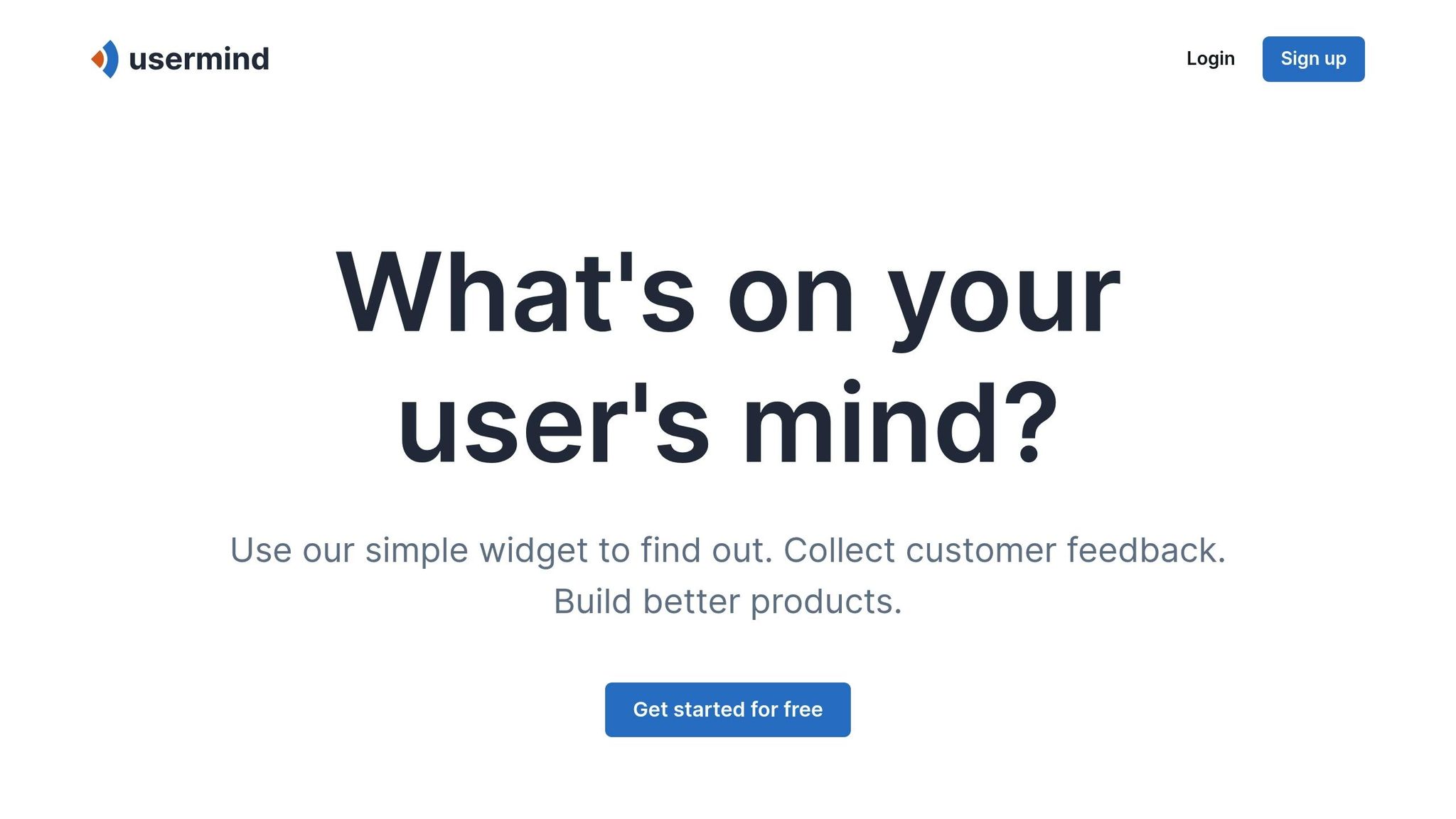
Usermind focuses on delivering tailored experiences throughout the customer lifecycle by pulling together data from various sources and uncovering critical behavioral patterns.
AI Capabilities
With its use of predictive analytics and machine learning, Usermind can anticipate customer behavior and create automatic customer segments. This allows businesses to send highly specific and targeted communications.
Data Integration
One of Usermind’s key strengths lies in its ability to integrate data from both offline and online sources seamlessly. By connecting with tools like CRM systems, marketing automation platforms, and customer support channels, it provides a comprehensive view of each customer’s journey. This integrated approach is especially important considering that 57% of customers prefer call support as their primary communication method. Additionally, Usermind ensures businesses can track every customer interaction, regardless of where it occurs – online or offline.
Visualization, Reporting, and Automation
Usermind also stands out with its user-friendly interface, which makes it easy to design and visualize complete customer journeys. This includes everything from marketing campaigns to sales processes and customer service workflows. Its analytics and reporting tools translate customer behavior into actionable insights, enabling businesses to make informed decisions and continuously refine customer journeys. On top of that, the platform automates customer interactions across multiple channels, ensuring consistent engagement while cutting down on manual tasks.
10. Genesys DX
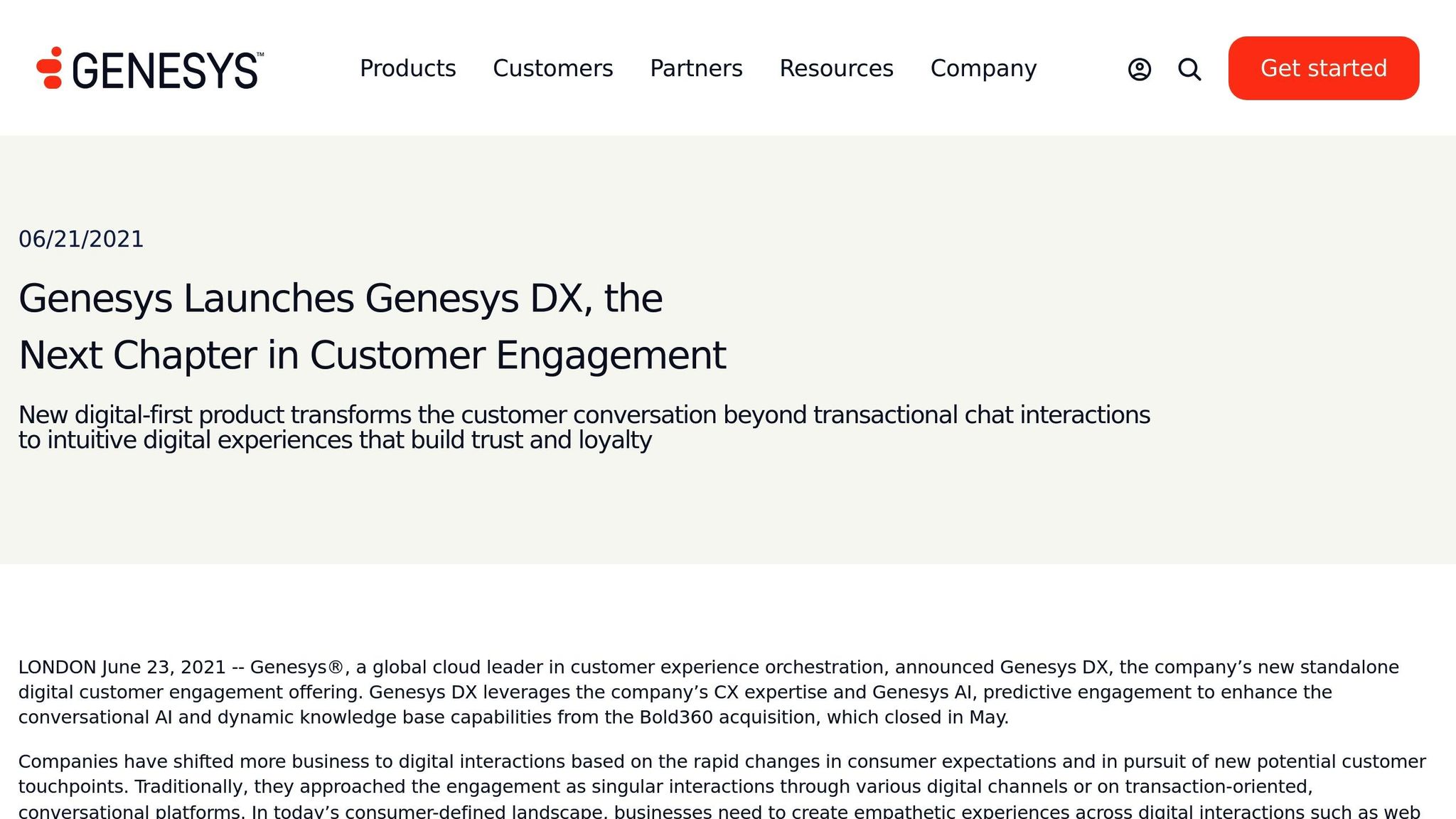
Genesys DX stands out as a tool that connects digital and physical customer experiences, offering advanced analytics to refine customer journey mapping. By blending offline and online interactions, it transforms raw data into actionable insights that drive impactful business outcomes.
AI Capabilities
At the heart of Genesys DX is its AI-powered predictive engagement, which anticipates customer needs and guides them toward the next best step in their journey. Its built-in AI also personalizes interactions and automates everyday tasks, streamlining operations.
What makes Genesys DX particularly effective is its Predictive Engagement technology. This feature identifies when customers stray from their intended path and determines the best way to re-engage them. The system uses AI to intelligently manage touchpoints and predict engagement patterns throughout the customer journey.
Data Integration
Genesys DX excels in integrating data from a variety of touchpoints, creating a unified data model that connects online and offline interactions seamlessly. It enables businesses to analyze customer journeys across both self-service and agent-supported channels, offering a comprehensive view of the entire experience.
By consolidating all interaction data into a single, unified profile for each customer, the platform eliminates traditional channel silos. It processes complex data automatically, allowing analysts to focus on resolving customer journey challenges rather than spending time on data preparation.
"We’re able to visualize where customers originate from when they switch channels, where they go next and why they abandon. Our management team now have data at their fingertips that they never could have dreamed of five years ago." – Elena Weller, Customer Experience Director, Arvig
This streamlined approach enables businesses to uncover trends and insights that were previously out of reach.
Visualization and Reporting Tools
Genesys DX offers robust visualization tools that present omnichannel interactions in near real-time. Features like Journey Flows, Journey Analyzer, and Funnel Analysis allow businesses to identify touchpoints that either enhance or disrupt customer satisfaction.
The platform’s reporting tools go beyond surface-level metrics, helping businesses pinpoint where conversions happen and where customers face obstacles. Instead of just highlighting symptoms, these tools help diagnose the root causes of customer experience issues.
The platform’s real-world impact is evident. For example:
- A major telecommunications company used Genesys DX to analyze churn drivers. While billing and TV issues were common, they discovered internet-related problems caused the largest revenue losses. By addressing two specific internet issues, they projected a 2% reduction in churn and $1.8 million in saved revenue over 12 months.
- A top retail bank leveraged the platform to address rising call volumes in payment journeys. By identifying problems in their self-service IVR channels, they estimated $3 million in savings by reducing call volume for first-time payment customers by 50%.
Automation for Journey Orchestration
Genesys DX takes the insights from data and visualizations a step further by automating engagement processes. It consolidates customer interactions across their journey into a ready-to-analyze data model. This automation extends to creating custom dashboards that combine real-time and historical data, offering actionable insights at a glance.
The platform is designed for quick deployment and ease of use, eliminating the need for extensive training. This accessibility ensures that team members across the organization – not just analysts – can make informed decisions quickly. By democratizing access to customer journey insights, Genesys DX empowers businesses to respond promptly to customer needs and optimize experiences across all channels.
"Genesys Predictive Engagement delivers more than chat. Their suite of digital engagement services comes at a reasonable, fixed cost and they offer deep customer journey analytics that let us see, understand and engage digital users in real time." – Polycom
Tool Comparison Chart
When selecting an AI-powered customer journey mapping tool, it’s essential to weigh performance across four key areas: AI features, data integration, reporting capabilities, and automation functions. The chart below provides a quick side-by-side comparison to help you make an informed decision.
| Tool | AI Features | Data Integration | Reporting & Visualization | Automation | Starting Price |
|---|---|---|---|---|---|
| SuperAGI Journey Orchestration | Visual workflow builder, real-time audience segmentation, AI agents for content creation, continuous learning optimization | Omnichannel messaging, seamless data flow across touchpoints | Real-time dashboards, visual journey flows | Trigger-based workflows, automated content creation | Custom pricing |
| Qualtrics XM | Predictive analytics, sentiment analysis, behavioral pattern recognition | CRM integration, multi-source data collection | Advanced dashboards, experience insights | Automated alerts, response triggering | Custom pricing |
| Adobe Experience Platform | Machine learning personalization, predictive scoring, AI-powered segmentation | Real-time customer data platform, unified profiles | Journey visualization, attribution reporting | Automated journey orchestration, dynamic content delivery | Custom pricing |
| Pointillist | Behavioral analytics, predictive modeling, AI-driven insights | Cross-channel data unification, real-time integration | Interactive journey maps, conversion funnel analysis | Journey optimization, personalized messaging | Custom pricing |
| InMoment | Natural language processing, predictive analytics, sentiment analysis | Multi-channel feedback integration, CRM connectivity | Real-time reporting, customizable dashboards | Feedback collection, response workflows | Custom pricing |
| Thunderhead ONE | Real-time decisioning, predictive engagement, behavioral AI | Unified customer data model, omnichannel integration | Journey analytics, performance metrics | Automated personalization, dynamic journey adaptation | Custom pricing |
| Kitewheel | Machine learning algorithms, predictive analytics, AI optimization | Real-time data processing, multi-system integration | Visual journey designer, impact analysis | Campaign execution, dynamic orchestration | Custom pricing |
| JourneyVision Pro | Advanced predictive capabilities, multi-channel tracking, intuitive AI interface | Social media, email, and phone integration | Interactive visualizations, comprehensive analytics | Journey updates, personalized recommendations | $25/month |
| Usermind | Behavioral prediction, AI-driven insights, customer scoring | CRM and marketing platform integration | Journey performance dashboards, ROI tracking | Workflow execution, personalized engagement | Custom pricing |
| Genesys DX | Predictive engagement, AI-powered personalization, automated task management | Unified data model connecting online and offline interactions | Near real-time visualization, journey flows, funnel analysis | Automated engagement processes, custom dashboard creation | Custom pricing |
Breaking Down the Key Factors
Pricing varies widely. JourneyVision Pro is the only tool with a fixed starting price of $25/month, making it a standout for budget-conscious buyers. In contrast, tools like Adobe Experience Platform and Genesys DX use custom pricing to accommodate enterprise-level needs.
AI capabilities are a major differentiator. Tools such as SuperAGI Journey Orchestration and Adobe Experience Platform stand out for their advanced machine learning features. On the other hand, JourneyVision Pro provides solid predictive tools at a much lower cost, appealing to smaller businesses.
When it comes to data integration, Adobe Experience Platform and Genesys DX excel at unifying online and offline data, which is crucial for businesses managing both physical and digital customer interactions. Similarly, Kitewheel and Usermind offer seamless integration with existing marketing systems, avoiding the need for expensive system overhauls.
For reporting and visualization, enterprise tools like Qualtrics XM and Thunderhead ONE shine with their advanced dashboards, designed to pinpoint friction points and analyze customer behavior. For example, UPS leveraged Qualtrics XM to analyze feedback, leading to a 25% drop in delivery complaints.
Automation is another critical feature. Tools like InMoment and Pointillist balance scalability and automation, making them a strong fit for mid-sized businesses. Meanwhile, enterprise solutions like Adobe Experience Platform and Genesys DX handle high-volume, multi-channel interactions effectively.
"Journey maps are living documents. Don’t set goals around being ‘done.’ It’s more important to work towards being accurate, and that may take multiple sessions and sources of input that will change over time."
- Danielle Beecham, Lead UX Researcher at Viz.ai
Who Should Choose What?
- Small businesses: JourneyVision Pro offers excellent predictive capabilities for just $25/month.
- Mid-sized companies: Consider InMoment or Pointillist for a balance of features and scalability.
- Enterprises: Solutions like Adobe Experience Platform and Genesys DX are ideal for managing complex, high-volume interactions.
With the customer experience technology market projected to grow by 15% annually through 2026, early adopters stand to gain a significant edge over competitors.
Final Thoughts
A striking 83% of companies using AI-powered journey mapping report improved customer satisfaction, while 75% link it to direct revenue growth. As customers increasingly demand a seamless blend of offline and online interactions across all channels, embracing these tools isn’t just smart – it’s necessary to stay ahead. The next step? Evaluate your business’s size, budget, and unique needs to choose the right tool.
For small businesses, JourneyVision Pro offers solid predictive capabilities at just $25/month. Mid-sized companies might find solutions like InMoment or Pointillist more fitting, while enterprises could benefit from robust platforms such as Adobe Experience Platform or Genesys DX.
It’s also crucial to ensure your chosen tool complies with regulations like the California Consumer Privacy Act (CCPA) and Colorado’s AI Act. This means focusing on data minimization, obtaining explicit consent, and maintaining rigorous compliance audits. With over 40% of U.S. enterprises already leveraging AI, regulatory oversight is only growing stronger.
Beyond compliance, integration is key. Your AI insights should work seamlessly with existing systems like CRM platforms, email marketing tools, and analytics software, ensuring scalability as your business evolves.
Remember, journey maps are not static. As Danielle Beecham of Viz.ai explains:
"Journey maps are living documents. Don’t set goals around being ‘done.’ It’s more important to work towards being accurate".
Choose a tool that supports real-time updates to adapt as customer behavior shifts.
Finally, set clear objectives – whether it’s cutting service costs by 21% or boosting customer satisfaction by 20%. Aligning your tool selection with these goals ensures you’re tackling your biggest challenges head-on and moving closer to delivering cohesive, data-driven customer experiences.
FAQs
How do AI tools improve customer journey mapping compared to traditional approaches?
AI tools are transforming how businesses approach customer journey mapping, bringing in real-time insights, predictive analytics, and automated updates. These features make it easier for companies to quickly respond to customer behaviors, predict future needs, and create highly tailored experiences.
Traditional methods simply can’t match the ability of AI-driven systems to analyze massive amounts of data from both online and offline channels. By uncovering patterns and opportunities that might be missed otherwise, AI enables smarter decisions and creates smoother, more personalized customer journeys.
What should businesses look for when selecting an AI tool for customer journey mapping?
When selecting an AI tool for customer journey mapping, it’s essential to consider factors like user-friendliness, how well it works with your current systems, and whether it can grow alongside your business. Features like real-time analytics and the ability to combine online and offline data effortlessly are crucial for gathering insights you can act on.
It’s also important to ensure the tool adheres to data privacy regulations to safeguard customer information and build trust. By focusing on these aspects, you can choose a solution that fits your needs and supports your business over the long haul.
How do AI tools for customer journey mapping stay compliant with privacy laws like CCPA and the Colorado AI Act?
AI tools built for customer journey mapping are designed to align with privacy laws like the CCPA and the Colorado AI Act by integrating strong privacy protections. Features such as data governance frameworks, consent management systems, and privacy-by-design principles help ensure user information stays secure throughout the entire customer journey.
Many of these tools also streamline compliance tasks by automating processes like handling user data requests or meeting regional privacy standards. This approach minimizes the risk of non-compliance while demonstrating a commitment to customer privacy, fostering trust along the way.








